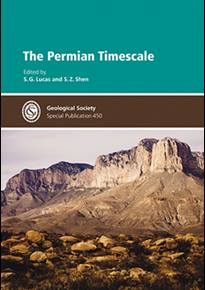
The eye is drawn to this long-awaited companion to The Triassic Timescale (SP 334) by the stunning view of Middle Permian strata in the Guadalupe Mountains, West Texas, featured on its cover. Contributions in these volumes follow the same thematic order, with those on the chronostratigraphic scale, its radioisotopic and magnetostratigraphic calibration, and isotope stratigraphy preceding chapters on marine and non-marine palaeontology and biostratigraphy.
The editors provide a concise overview of the following chapters, with some critical comment. Advances in radioisotopic dating and issues such as differences in the dating of the beginning of the Illawara Superchron are highlighted; carbon isotopes are included here because only strontium is considered in the chapter on isotope stratigraphy. The comprehensive review of the Permian chronostratigraphic scale that follows is a must-read for those new to Permian studies. The System boundaries and bases of the five stages of the Middle and Upper Permian series had been defined by Global Boundary Stratotype Sections and Points, and that for the Sakmarian was ratified after the volume was published, leaving only those for the two succeeding Lower Permian stages to be determined. The authors support the nine Permian stages, but consider none perfect and that the definitions of their bases are not immutable. Regional chronostratigraphic scales are reviewed critically and the Western European scheme (Autunian, Saxonian, Thuringian) is considered neither a suitable chronostratigraphic division of the System nor useful for correlation.
Advances in analytical techniques and methodology continue to refine the numerical calibration that underpins the Permian Timescale. A corollary of these developments is that previous determinations may require reassessment or recalculation and, in some cases, re-analysis. Equally important is the progress in development of a geomagnetic polarity timescale and its calibration to stage boundaries.
Rugose corals did not survive into the Triassic, but their demise is shown to have begun in the Mid-Permian. Reviews of the biostratigraphy of conodonts, radiolarians, ammonoids, foraminifers, brachiopods and the micro- and macro-flora highlight the influence of palaeogeographical changes and other events, and factors such as provincialism.
A contribution on Late Pennsylvanian to Early Triassic conchostracan biostratigraphy is particularly welcome because system boundaries are too often the limits of studies. This, as well as the contributions on tetrapods and related ichnostratigraphy, link to corresponding ones in The Triassic Timescale (SP 334).
The book is well-produced and generally well-illustrated; some figures benefit from colour, but others are too small. With the specialist contributions and extensive bibliographies this is a recommended resource for Permian studies.
Reviewed by: Geoff Warrington
THE PERMIAN TIMESCALE, edited by S G LUCAS AND S Z SHEN, 2018. Published by: the Geological Society of London SP450. 458pp (hbk) ISBN 978-1-78620-282-6. List Price: £120.00. Fellow’s Price: £60.00. W:
www.geolsoc.org.uk/SP450